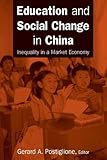Education and Social Change in China : Inequality in a Market Economy.
Material type: TextPublisher: Armonk : Routledge, 2006Copyright date: ©2010Description: 1 online resource (224 pages)Content type: text Media type: computer Carrier type: online resourceISBN: 9781317472346Subject(s): Education and state -- China -- Congresses | Education, Rural -- China -- Congresses | Educational equalization -- China -- Congresses | Educational sociology -- China -- CongressesGenre/Form: Electronic books.Additional physical formats: Print version:: Education and Social Change in China: Inequality in a Market EconomyDDC classification: 306.43/20951 LOC classification: LC191.8.C5 -- E38 2006ebOnline resources: Click to View
TextPublisher: Armonk : Routledge, 2006Copyright date: ©2010Description: 1 online resource (224 pages)Content type: text Media type: computer Carrier type: online resourceISBN: 9781317472346Subject(s): Education and state -- China -- Congresses | Education, Rural -- China -- Congresses | Educational equalization -- China -- Congresses | Educational sociology -- China -- CongressesGenre/Form: Electronic books.Additional physical formats: Print version:: Education and Social Change in China: Inequality in a Market EconomyDDC classification: 306.43/20951 LOC classification: LC191.8.C5 -- E38 2006ebOnline resources: Click to View Cover -- Half Title -- Title Page -- Copyright Page -- Table of Contents -- List of Tables and Figure -- Foreword -- Map: Fieldwork Research Sites -- Part I: Inequalities and Development Discourse -- 1. Schooling and Inequality in China -- 2. Challenging the Gendered Dimensions of Schooling: The State, NGOs, and Transnational Alliances -- Part II. Rural Northwest -- 3. Poverty, Health, and Schooling in Rural China -- 4. Tibetan Girls' Education: Challenging Prevailing Theory -- Part III. Rural Southwest -- 5. Rural Classroom Teaching and Nonfarm Jobs in Yunnan -- 6. Education in Rural Tibet: Development, Problems, and Adaptations -- Part IV. Urban Divisions: Migrants and the Middle Class -- 7. The Integration of Migrant Children in Beijing Schools -- 8. Educational Stratification and the New Middle Class -- List of Contributors -- Index.
Market reform, financial decentralization, and economic globalization have greatly accentuated China's social and regional inequalities. Education is expected to address these inequalities in a context of rapid social change, including the rise of an urban middle class, changed status of women, resurgence of ethnic identities, growing rural to urban migration, and lingering poverty in remote areas. But some argue that state policies have not sufficiently addressed inequitable practices, and that schools actually perpetuate and reproduce inequities, giving rise to a new system of social stratification driven more by market forces than socialist principles. Featuring all original, previously unpublished material, this volume examines this argument through analysis of selected aspects of educational stratification in China during the reform era. Chapters focus on the new urban middle class, poor rural residents, the migrant population in urban areas, rural girls, and ethnic minorities. The contributors are established scholars in the field, and they build a conceptual framework for assessing the degree to which China's educational reforms are inclusive, equitable, and integrative across social categories and groups.
Description based on publisher supplied metadata and other sources.
Electronic reproduction. Ann Arbor, Michigan : ProQuest Ebook Central, 2018. Available via World Wide Web. Access may be limited to ProQuest Ebook Central affiliated libraries.

There are no comments on this title.